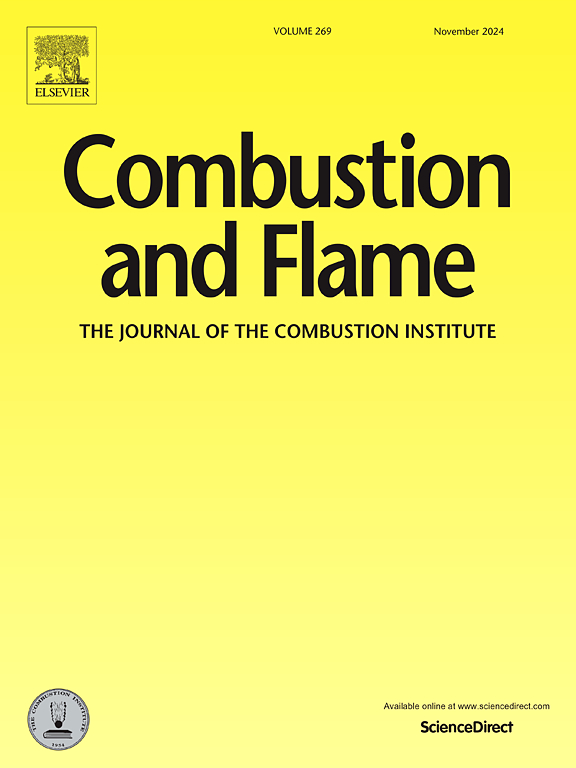Effect of hydroxypropyl methylcellulose and ferric chloride on hypergolic ignition of solidified ethanol fuels
IF 5.8
2区 工程技术
Q2 ENERGY & FUELS
引用次数: 0
Abstract
This study investigates the hypergolic ignition of reaction-driven solidified ethanol (RDSE) fuels, focusing on the effects of varying concentrations of hydroxypropyl methylcellulose (HPMC) gellant and ferric chloride (FeCl3) dopant. Fourier Transform Infrared Spectroscopy (FTIR) and thermogravimetric analysis (TGA) are employed to examine molecular interactions and thermal properties. FTIR results indicate that no new covalent bonds are formed upon adding FeCl3, whereas interactions primarily governed by weak hydrogen and ionic bonds. The apparent activation energy () has been determined for the fuel samples using iso-conversional model-free kinetics approach and found that decreased with HPMC and FeCl3 concentrations. Hypergolic ignition delay tests were attempted with the droplet study rocket grade hydrogen peroxide (90 % RGHP; H2O2) as an oxidizer, demonstrated that increasing HPMC concentration by 3 wt.% reduced ignition delay by ∼20 %, while a 5 wt.% increase in FeCl3 concentration led to a ∼25 % reduction. Higher fuel temperatures enhanced the wetting and spreading behavior of H2O2 droplets, improving oxidizer-fuel interaction and reducing ignition delay. Overall, solidification of ethanol using HPMC with FeCl3 eliminates the catalyst as FeCl3 acts as both catalyst and binding agent.
羟丙基甲基纤维素和氯化铁对固化乙醇燃料自燃的影响
本研究研究了反应驱动的固化乙醇(RDSE)燃料的自燃着火,重点研究了不同浓度羟丙基甲基纤维素(HPMC)凝胶剂和氯化铁(FeCl3)掺杂剂的影响。傅立叶变换红外光谱(FTIR)和热重分析(TGA)被用来研究分子的相互作用和热性质。FTIR结果表明,加入FeCl3后没有形成新的共价键,而相互作用主要由弱氢键和离子键控制。采用等转换无模型动力学方法测定了燃料样品的表观活化能(Ea),发现Ea随HPMC和FeCl3浓度的降低而降低。用液滴研究火箭级过氧化氢(90% RGHP;H2O2)作为氧化剂,研究表明,HPMC浓度增加3wt .%可减少~ 20%的点火延迟,而FeCl3浓度增加5wt .%可减少~ 25%的点火延迟。较高的燃料温度增强了H2O2液滴的润湿和扩散行为,改善了氧化剂与燃料的相互作用,减少了点火延迟。总体而言,使用HPMC和FeCl3固化乙醇消除了催化剂,因为FeCl3既是催化剂又是粘合剂。
本文章由计算机程序翻译,如有差异,请以英文原文为准。
求助全文
约1分钟内获得全文
求助全文
来源期刊

Combustion and Flame
工程技术-工程:化工
CiteScore
9.50
自引率
20.50%
发文量
631
审稿时长
3.8 months
期刊介绍:
The mission of the journal is to publish high quality work from experimental, theoretical, and computational investigations on the fundamentals of combustion phenomena and closely allied matters. While submissions in all pertinent areas are welcomed, past and recent focus of the journal has been on:
Development and validation of reaction kinetics, reduction of reaction mechanisms and modeling of combustion systems, including:
Conventional, alternative and surrogate fuels;
Pollutants;
Particulate and aerosol formation and abatement;
Heterogeneous processes.
Experimental, theoretical, and computational studies of laminar and turbulent combustion phenomena, including:
Premixed and non-premixed flames;
Ignition and extinction phenomena;
Flame propagation;
Flame structure;
Instabilities and swirl;
Flame spread;
Multi-phase reactants.
Advances in diagnostic and computational methods in combustion, including:
Measurement and simulation of scalar and vector properties;
Novel techniques;
State-of-the art applications.
Fundamental investigations of combustion technologies and systems, including:
Internal combustion engines;
Gas turbines;
Small- and large-scale stationary combustion and power generation;
Catalytic combustion;
Combustion synthesis;
Combustion under extreme conditions;
New concepts.
 求助内容:
求助内容: 应助结果提醒方式:
应助结果提醒方式:


